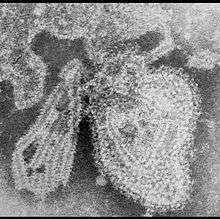Mumps virus
| mumps virus (MuV) | |
|---|---|
 | |
| TEM micrograph of a mumps virus particle. | |
| Virus classification | |
| Group: | Group V ((-)ssRNA) |
| Order: | Mononegavirales |
| Family: | Paramyxoviridae |
| Genus: | Rubulavirus |
| Type species | |
| Mumps virus | |
Mumps virus is the causative agent of mumps, a well-known common childhood disease characterised by swelling of the parotid glands, salivary glands and other epithelial tissues, causing high morbidity and in some cases more serious complications such as deafness. Natural infection is currently restricted to humans and the virus is transmitted by direct contact, droplet spread, or contaminated objects.
It is considered a vaccine-preventable disease, although significant outbreaks have occurred in recent years in developed countries such as America, in areas of poor vaccine uptake. These have allowed the further evaluation and ennumeration of its efficacy (~75–85% after two doses of MMR).[1]
Mumps virus belongs to the genus Rubulavirus in the family Paramyxoviridae and produces roughly spherical, enveloped virions of about 200 nm in diameter.[2] The mumps virus genome is a linear, single-stranded molecule of negative-sense RNA and 15,384 nucleotides in length.[2]
Basic morphology

Electron microscopy (EM) revealed that the mumps virus (MuV), like other members of the Paramyxoviridae, has an enveloped virion of roughly spherical or pleiomorphic (variable) shape.[2] Paramyxovirus particles can have sizes ranging from 120–450 nm in diameter.
These particles consist of what is known as a ribonucleoprotein (RNP) complex: a single-stranded, linear RNA genome coated by nucleocapsid proteins (NP) in association with an RNA polymerase complex of both large (L) and phosphoprotein (P) subunits. It has been estimated that over 2,000 such NP molecules coat the genome along with about 250 P and 25 L molecules.
This RNP structure interacts with the viral envelope via matrix (M) proteins that are evenly distributed around the virion. The envelope, a lipid bilayer derived from the host-cell plasma membrane, harbours multiple copies of a number of glycoproteins required for virus entry and exit: hemagglutinin-neuraminidase (HN), fusion (F), and the small hydrophobic (SH) protein.
This molecular assembly of protein, RNA, and lipids allows a single virus to bind to and infect specific cells and replicate itself and finally exit the cell to be transmitted to the next susceptible host.
Genotypes
Although there is only one serotype of the mumps virus, according to recent update by WHO (June 2012), there are currently 12 genotypes A-N, (namely A, B, C, D, F, G, H, I, J, K, L, N) excluding (E and M). L-Zagreb vaccine strain comes under genotype N. The typing scheme is based on the sequence of the small hydrophobic (SH) gene.
There are several subgenotypes (D1, D2 G1, G2, H1, H2) which are designated by numerals after the letter. G2 is the current subgenotype circulating in the Indian subcontinent.[3]
Among vaccine strains, Jerryl Lynn and Rubini belong to genotype A, Urabe is genotype B. It is not clear yet if there is any clinical significance to the genotypes.
Pathogenesis
The mumps virus can infect ependymal cells in the central nervous system.[4]
Vaccination
Several strains are used to vaccinate against mumps. These include the strains Jerryl Lynn, L-Zagreb, Leningrad-3 and Rubini and Urabe.
Universal mumps vaccination was introduced in the United Kingdom in 1988.
References
- ↑ CDC list of articles pertaining to the contemporary American mumps outbreaks
- 1 2 3 Hviid A, Rubin S, Mühlemann K (March 2008). "Mumps". The Lancet. 371 (9616): 932–44. doi:10.1016/S0140-6736(08)60419-5. PMID 18342688.
- ↑ Mishra, B.; Pujhari, S. K.; Dhiman, V.; Mahalakshmi, P.; Bharadwaj, A.; Pokhrel, S.; Sharma, D.; Sharma, M.; Bhatia, D.; Ratho, R. K. (2013). "Genotyping and subtyping of mumps virus isolates from the Indian subcontinent". Archives of Virology. 158 (11): 2359–2363. doi:10.1007/s00705-013-1717-4. PMID 23685897.
- ↑ Tardieu M, Weiner HL (January 1982). "Viral receptors on isolated murine and human ependymal cells". Science. 215 (4531): 419–21. doi:10.1126/science.6276976. PMID 6276976.
- "Mumps virus". NCBI Taxonomy Browser. 11161.